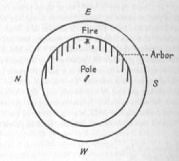Caddo Sibling or Cousin Nomenclature
The sibling or cousin nomenclature, I may say incidentally, was quite difficult to work out, as White Moon persistently assumed that the Indian and the English systems were the same. It was only through testing by the genealogical tables that the differentiation became clear first to me, then to him. And then one of the genealogical tables, in one case, had to be revised, a woman who had been described as a father’s sister having to be reclassified as a parallel cousin. As for the principles of seniority which prevail, as we are to see, in this part of the … Read more

